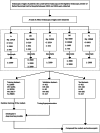A deep learning approach for gastroscopic manifestation recognition based on Kyoto Gastritis Score
- PMID: 39498518
- PMCID: PMC11539395
- DOI: 10.1080/07853890.2024.2418963
A deep learning approach for gastroscopic manifestation recognition based on Kyoto Gastritis Score
Abstract
Objective: The risk of gastric cancer can be predicted by gastroscopic manifestation recognition and the Kyoto Gastritis Score. This study aims to validate the applicability of AI approaches for recognizing gastroscopic manifestations according to the definition of Kyoto Gastritis Score, with the goal of improving early gastric cancer detection and reducing gastric cancer mortality.
Methods: In this retrospective study, 29013 gastric endoscopy images were collected and carefully annotated into five categories according to the Kyoto Gastritis Score, i.e. atrophy (A), diffuse redness (DR), enlarged folds (H), intestinal metaplasia (IM), and nodularity (N). As a multi-label recognition task, we propose a deep learning approach composed of five GAM-EfficientNet models, each performing a multiple classification to quantify gastroscopic manifestations, i.e. no presentation or the severity score 0-2. This approach was compared with endoscopists of varying years of experience in terms of accuracy, specificity, precision, recall, and F1 score.
Results: The approach demonstrated good performance in identifying the five manifestations of the Kyoto Gastritis Score, with an average accuracy, specificity, precision, recall, and F1 score of 78.70%, 91.92%, 80.23%, 78.70%, and 0.78, respectively. The average performance of five experienced endoscopists was 72.63%, 90.00%, 77.68%, 72.63%, and 0.73, while that of five less experienced endoscopists was 66.60%, 87.44%, 70.88%, 66.60%, and 0.66, respectively. The sample t-test indicates that the approach's average accuracy, specificity, precision, recall, and F1 score for identifying the five manifestations were significantly higher than those of less experienced endoscopists, experienced endoscopists, and all endoscopists on average (p < 0.05).
Conclusion: Our study demonstrates the potential of deep learning approaches on gastric manifestation recognition over junior, even senior endoscopists. Thus, the deep learning approach holds potential as an auxiliary tool, although prospective validation is still needed to assess its clinical applicability.
Keywords: Kyoto Gastritis Score; deep learning; gastric cancer; gastroscopic manifestations.
Conflict of interest statement
Ao Liu, Xilin Zhang, Jiaxin Zhong, Zilu Wang, Zhenyang Ge, Zhong Wang, Xiaoya Fan, and Jing Zhang declare no conflict of interest to disclose.
Figures





Similar articles
-
Association between gastric cancer and the Kyoto classification of gastritis.J Gastroenterol Hepatol. 2017 Sep;32(9):1581-1586. doi: 10.1111/jgh.13764. J Gastroenterol Hepatol. 2017. PMID: 28217843
-
Endoscopic Kyoto classification of Helicobacter pylori infection and gastric cancer risk diagnosis.World J Gastroenterol. 2020 Feb 7;26(5):466-477. doi: 10.3748/wjg.v26.i5.466. World J Gastroenterol. 2020. PMID: 32089624 Free PMC article. Review.
-
Validity of endoscopic features for the diagnosis of Helicobacter pylori infection status based on the Kyoto classification of gastritis.Dig Endosc. 2020 Jan;32(1):74-83. doi: 10.1111/den.13486. Epub 2019 Sep 26. Dig Endosc. 2020. PMID: 31309632
-
Endoscopy-based Kyoto classification score of gastritis related to pathological topography of neutrophil activity.World J Gastroenterol. 2020 Sep 14;26(34):5146-5155. doi: 10.3748/wjg.v26.i34.5146. World J Gastroenterol. 2020. PMID: 32982115 Free PMC article.
-
[Clinical Application of the Kyoto Classification of Gastritis].Korean J Helicobacter Up Gastrointest Res. 2023 Jun;23(2):89-98. doi: 10.7704/kjhugr.2023.0013. Epub 2023 Jun 2. Korean J Helicobacter Up Gastrointest Res. 2023. PMID: 40502286 Free PMC article. Review. Korean.
References
-
- Katai H, Ishikawa T, Akazawa K, et al. . Five-year survival analysis of surgically resected gastric cancer cases in japan: a retrospective analysis of more than 100,000 patients from the nationwide registry of the Japanese gastric cancer association (2001-2007). Gastric Cancer Off J Int Gastric Cancer Assoc Jpn Gastric Cancer Assoc. 2018;21(1):144–154. doi:10.1007/s10120-017-0716-7. - DOI - PubMed
MeSH terms
LinkOut - more resources
Full Text Sources
Medical
Research Materials
